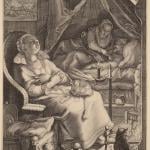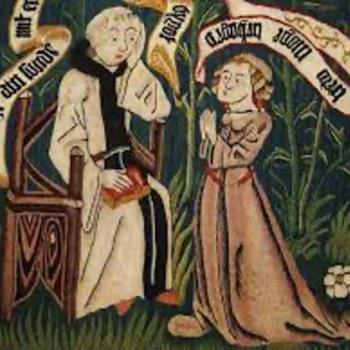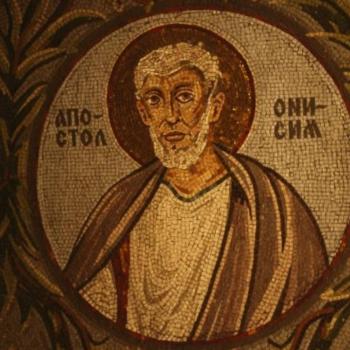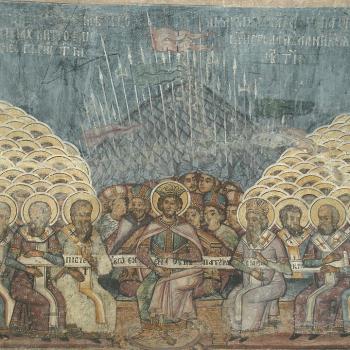As I stared at the fragments of the cross of Christ on display in the Cathedral of Palma de Mallorca last year, I was struck with the apparent contradictions of its display—this piece of wood was housed in an exceptionally ornate reliquary. Christ may have died a social outcast at the hands of oppressive political powers, but later imperial figures paid to have the cross enshrined in gold.
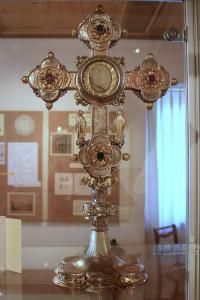
Cyril of Jerusalem tells us in the mid fourth century that the cross of Christ had been found and the “whole world” was filled with its fragments. (Cyril, Catecheses IV.10). About 50 years later, the person who discovered it had been identified: Helena, mother of Constantine. In the first iteration of the story (which has three distinct versions), Helena is given a vision from God to search for the cross amidst some rubble in Jerusalem. She finds “three crosses jumbled together” and, along with the bishop of Jerusalem, discerns Christ’s cross through a healing miracle.
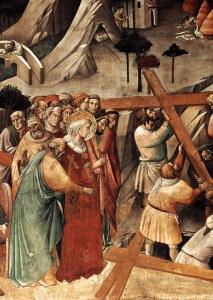
Afterwards, she sends the nails embedded in the cross to her son, who incorporates them into his helmet and the bridle of his horse. (Rufinus, The Church History of Rufinus of Aquileia X.7-8) While most modern scholars dispute that Helena was the one to find the ‘true cross,’ two important features of Helena’s life and legacy are on display in this legend: piety and power. Like the reliquary I encountered, Helena’s faith convicted her to house a fragment of the true cross in precious metal (sliver, in this case).
In my continued reflection on the council of Nicaea for the 1700th anniversary (see post: here), and the Mothers of the Church (see post: here), Helena is a natural choice to discuss. Not only is she the mother of Constantine, who called the council of Nicaea, but she also embodies the very tension that we see at the council: faith and politics, theological orthodoxy and imperial peace. What we learn from Helena in particular is that privilege is to be wielded for God’s kingdom, to be used for the promotion of peace and the care of the oppressed. The mother of Nicaea spreads Christianity through charity.
Life
Like most women from Late Antiquity, what is known of Helena is mostly on account of her relationship to men—thus, details of her life are patchy, especially since no writings from her own hand survive. She was born around 248 or 249 A.D. in an unknown location, though Turkey, Serbia, Mesopotamia, Germany, and England have been suggested. She probably comes from modest social origins, often being referred to as a stabularia in ancient sources, a woman who works in a stable or inn. This was not a reputable career. As Jan Willem Drijvers notes, “In antiquity the social prestige of somebody working at an inn was low. The life of a stabularia was one spent in servitude, very probably including sexual servitude” (Drijvers, Helena Augusta, 15). While ancient Christian sources were quick to point out that she had an unblemished character (perhaps to overcome any stereotypes), her rise to become empress was meteoric. Hence, Ambrose writes in the late fourth century, “Christ raised her (Helena) from the dung to royalty.” (Ambrose, Oration on the Death of Theodosius 42).
She met Constantius Chlorus, the future Roman Emperor and Constantine’s father, around 270. Her relationship to Constantius was complicated by her social status, which likely means she became his concubine (a common and accepted form of cohabitation), though never his wife. In any case, she was pregnant and gave birth to Constantine long before Constantius separated himself from Helena in 289 to marry a daughter of a current Caesar Augustus, Maximian. With his marriage to Theodora, Constantius could now become a Roman emperor. After her son Constantine’s promotion to become an emperor in York, England in 306, Helena likely joined Constantine’s court. According to Eusebius of Caesarea, Helena was converted to Christianity by her son, who became a Christian in 312. Like Constantine, Helena’s understanding of Christianity may have been complicated. As Julia Hillner notes, “We cannot know what being a Christian meant to her, but we should note that it is unclear whether Helena was ever baptized, even on her deathbed” (Hillner, Helena Augusta: Mother of the Empire, 79).
Piety and Power
The ancient sources indicated that Helena had exceptional power and piety, as mentioned above. She must have been influential in Constantine’s court, as she was featured on minted coins after 324, granted the title ‘Augusta’ by her Son, and given control over the imperial treasury. Paulinus of Nola and Sulpicius Severus even claim she was Constantine’s co-ruler (Paulinus, Epistle 31.4, Severus Chronicle II.33), though we must be mindful that Helena is not wielding independent power as a true co-ruler, as one might expect from a modern royal woman. Her power is contingent upon powerful men—she is given all of these on account of her position, loyalty, and character.
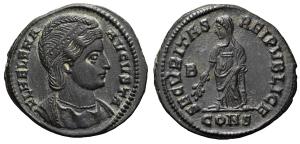
Her piety is best detailed in the last few years of her life, when she travels throughout Palestine after the council of Nicaea in 325. Eusebius of Caesarea, the chief contemporary source for her life, describes her main desire: to give “suitable adoration to the footsteps of the Saviour” (Eusebius, Life of Constantine III. 42). In other words, she wanted to walk and pray where Christ lived, like Egeria the pilgrim several decades later (see a post about her, here). As a pilgrim, she exhibited Christian piety throughout her travels by visiting and adorning churches, giving to the poor, and other acts of charity. “She made innumerable gifts to the unclothed and unsupported poor, to some making gifts of money, to others abundantly supplying what was needed to cover the body. Others she set free from prison and from mines where they laboured in harsh conditions, she released the victims of fraud, and yet others she recalled from exile” (Eusebius, Life of Constantine III.44).
Some scholars have pointed out there are likely political motivations at play in Helena’s journey, which nuance her endeavor. It is possible that Helena was sent out by Constantine to restore political peace due to unrest in the eastern provinces, of which he had only taken control over in 324. Could her gifts to the local poor and prisoners be a ploy to curry favor for her son? Her adornment of churches might also be read as an attempt to win favor for Christianity against Roman religion, which Constantine had recently promoted—beautiful churches might rival Roman temples. Finally, the Council of Nicaea was not considered to be a universal success by its participants nor local congregations—the opposite, really. There were many in Palestine (Eusebius of Caesarea included) who were nervous about the language of the creed and thought that Arius and others were treated unfairly. Further, others were frustrated because it did not condemn enough. According to Athanasius of Alexandria, Helena met with Eustathius of Antioch (an important bishop at Nicaea who opposed Arianism) at some point around 327 or 328—the meeting did not go well. Apparently, he “had insulted her” (Athanasius, History of the Arians 4), which lead to his deposition in 328, though we do not have the exact details. We do know that Eustathius was frustrated by the council of Nicaea because it only condemned Arius himself—he wanted others, including Eusebius of Caesarea, to lose their posts (for the relevant fragment, see: Eustathius, Fragment 79, in Fontes Nicaea Synodi, 39) Could it be that Eustathius complained about the outcome of Nicaea to her, the very thing that Helena came to preserve and protect? We cannot know for sure. Helena died shortly after in 328 or 329.
Wielding Christian Power: The Nicene Tension
It is easy to place dichotomies between power and piety, as we often do with Constantine or the Council of Nicaea. In the case of Helena, it is hard to know which portrait to believe: the Eusebian (piety) or Athanasian (politics) one. Without being able to discern from the sources themselves, it might be safest to assume that both are true and allow for the tension. Later sources certainly allow this to be the case.
As discussed in my previous post on the council of Nicaea, there is a tension between power and orthodox faith. While theology and piety are central to the council, so too is Constantine’ political and religious agenda. This fusion of piety and power appear to be present in Helena’s life and work as well. Importantly, Helena did not attend the council itself, and her orthodoxy has been called into question by modern historians on account of her apparent role in the deposition of Eustathius and support of several ‘non-Nicenes’. But if we consider the tension between theology and politics, like the council itself, Helena seems to act in accordance with both. If this is true, then she is not only the Mother of Nicaea in begetting, caring, and supporting Emperor Constantine (who calls the council), but also in her spirit—she embodies the tensions, successes, and legacies of the council.
This spirit is unique to her position as a woman in late antiquity—she has little power on her own but is given power by her son. So how does she use it? As a woman of modest origins who found herself as an Augusta, she wielded her power towards peaceful and faithful ends, at least if the ancient accounts about her can be believed. Rather than the sword (which her son was a fan of), we are given a portrait of a women of grace and love towards the least of these, who “showered countless gifts upon the citizen bodies of every city,” in particular the marginalized (Eusebius, Life of Constantine III.44). Apparently, she was humble enough to do a servant’s work in setting out food, offering drink, and cleaning the hands of virgins of Christ. In this, “the empress of the world and mother of the empire appointed herself servant of the servants of Christ” (Rufinus, The Church History of Rufinus of Aquileia, X.8). I find myself convicted in reflecting on Helena’s life and legend: have I wielded the privilege of my position and place towards giving to the poor and protecting the marginalized? While this does not neatly map onto modern politics, it does show that Christian politicians, indeed all Christians, should wield their power in ways that cares for the least of these, not for themselves. While we might not adorn the cross with gold, we should use whatever gold and influence we have been given for God’s kingdom, like Helena.
Further Resources
Primary Sources:
No sources survive from Helena’s own hand. The most important contemporaneous literary source is Eusebius’ Life of Constantine. Later sources and legends develop around her, though their historical veracity has been questioned by many.
- Eusebius of Caesarea, Life of Constantine III. 42-7.
Secondary Sources
There are a host of great books and articles about Helena and the legends about her. I have included a few important ones to get you started.
- Drijvers, Jan Willem. Helena Augusta: The Mother of Constantine the Great and the Legend of her Finding of the True Cross (Leiden: Brill, 1992).
- Harbus, Antonina. Helena of Britain in Medieval Legend (Cambridge, UK: D.S. Brewer, 2002).
- Hillner, Julia. Helena Augusta: Mother of the Empire (Oxford: Oxford University Press, 2022).
- Pohlsander, Hans A. Helena: Empress and Saint (Chicago: Aries, 1995).
Historical Fiction
While I cannot say I have read this, Evelyn Waugh featured Helena as the main character in the novel bearing her name. You will have to let me know what you think of it!
- Evelyn Waugh, Helena, London 1950.



